Definition
From the Dictionary of Occupational Titles (DOT), the government’s book of jobs and job descriptions in America:
Administers specific therapeutic treatment of symptoms and disorders amenable to acupuncture procedures, as specifically indicated by supervising physician: Reviews patient’s medical history, physical findings, and diagnosis made by physician to ascertain symptoms or disorder to be treated. Selects needles of various lengths, according to location of insertion. Inserts needles at locations of body known to be efficacious to certain disorders, utilizing knowledge of acupuncture points and their functions. Leaves needles in patient for specific length of time, according to symptom or disorder treated, and removes needles. Burns bark of mugwort tree in small strainer to administer moxibustion treatment. Covers insertion area with cloth and rubs strainer over cloth to impart heat and assist in relieving patient’s symptoms.
Connecticut law requires only skilled professionals to practice acupuncture. Physicians must complete 60 hours of postsecondary study. Acupuncturists are required to have successful completion of a course of study from an accredited program by the Accreditation Commission for Acupuncture and Oriental Medicine.
Philosophy
The driving force behind acupuncture is the belief that the body is a bustling network of information and energy with the tools to heal and rejuvenate itself. Acupuncture seeks to aid the body in this healing by promoting the healthy flow of energy throughout that network. Central to this effort is the concept of Qi.
Qi is a life force and represents air. It is flowing throughout the body, providing energy, nourishment, and information. Qi is created by the body’s organs and flows along highways called meridians. The ability of Qi to flow along these meridians as required, is important to the natural healing capabilities of the body, and it is along these meridians that the flow of Qi can be manipulated with the stimulation of specific points on the body.
Yin Yang represents balance and harmony in equilibrium. It is when the body is balanced that optimal health and wellbeing are achieved. Yin is open, receptive, and cool, while Yang represents movement and heat. Certain symptoms or conditions fall into one of these two categories or represents an imbalance in them. Acupuncture seeks to aid in the flow of energy, to equalize these forces in the body and achieve equilibrium.
History
Acupuncture has been identified as a component of one of the oldest paradigms of medicine recorded. Ancient Chinese medicine boasts the oldest medical text on earth, The Yellow Emperor’s Canon of Medicine, a text still utilized today by TCM practitioners. This book is estimated to have been written between 221 BC and 220 AD. Other literature of that time period, including Nan Jing, outlines origins of disease, detailed and complex methods of diagnosis and treatments including a system of therapeutic needling.
The earliest record of acupuncture and pulse diagnosis in practice was around 500 BC, a physician named Bian Que. All of the medical works written by Que have been lost, but were thought to document much of his practice of acupuncture. Huangfu Mi (214-282 AD) was the first to compile a monograph on acupuncture, which included 12 volumes detailing the practice and theory of Traditional Chinese Medicine and acupuncture.
Acupuncture did not find its way to the West for centuries, but was of interest to physicians as soon as they were exposed to it.
Acupuncture, as a term, came from a Dutch physician, Rhyne during his visit to Asia during the early 17th century. In 1821, John Churchill was responsible for publishing works describing treatments involving acupuncture. Acupuncture and its treatment for pain was referenced in 1823 in the first edition of Lancet, a medical journal still respected today.
In 1997, the Natural Institute of Health hosted a consensus conference on acupuncture, developing the definition:
Acupuncture describes a family of procedures involving stimulation of anatomical locations on the skin by a variety of techniques. There are a variety of approaches to diagnosis and treatment in American acupuncture, which incorporates medical traditions from China, Japan, Korea, and other countries. The most studied mechanism of stimulation of acupuncture points employs penetration of the skin by thin, solid, metallic needles, which are manipulated manually or by electrical stimulation.
Acupuncture continues to grow in popularity in the United States. It is estimated that one in 10 Americans have tried some form of acupuncture. Forty-three states license practitioners and thirty states do not require a physician’s referral.
References:
- www.ct.gov
- www.naturalmedtext.com
- Acupuncture. Consensus Development Conference Statement. National Institutes of Health. November 3-5, 1997. Available online [accessed August 25, 2004].
